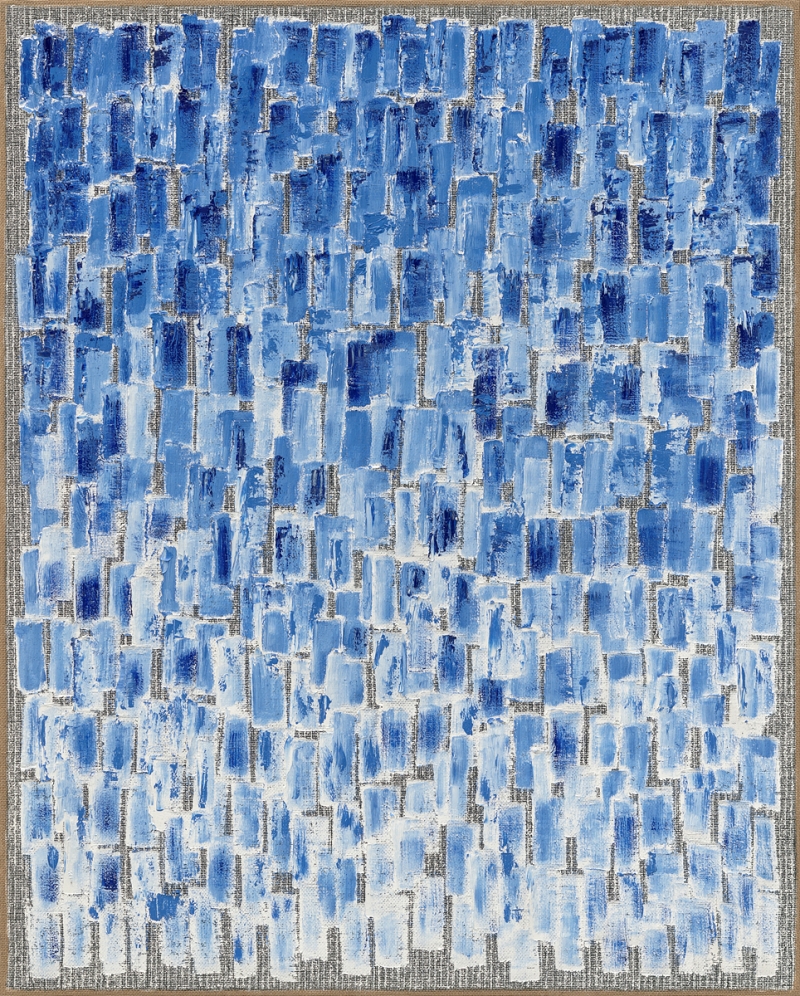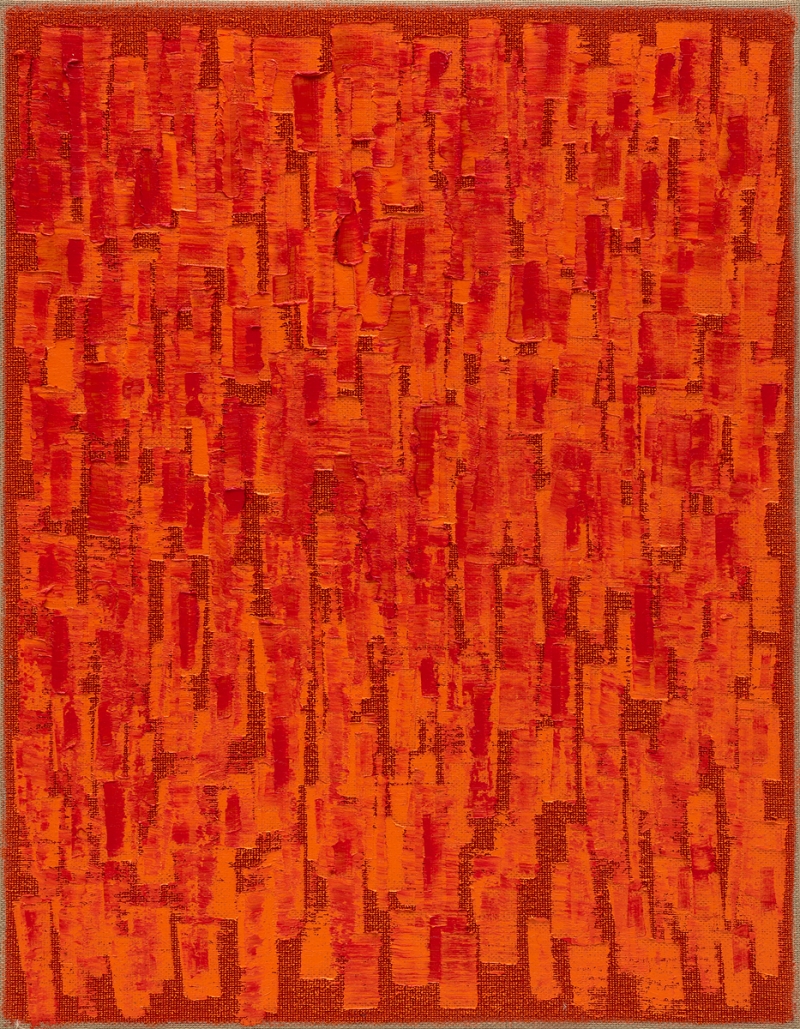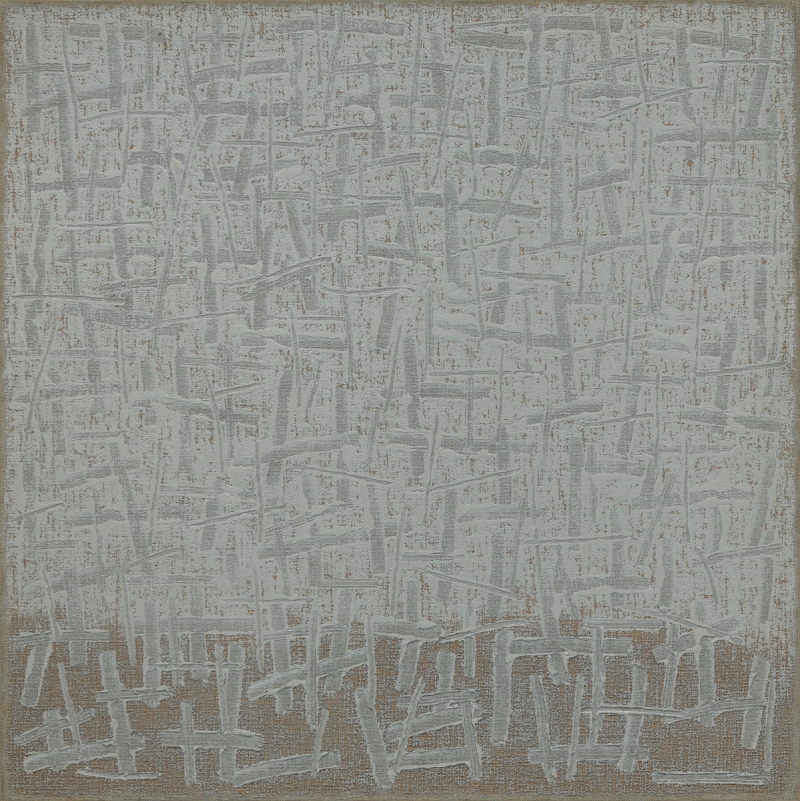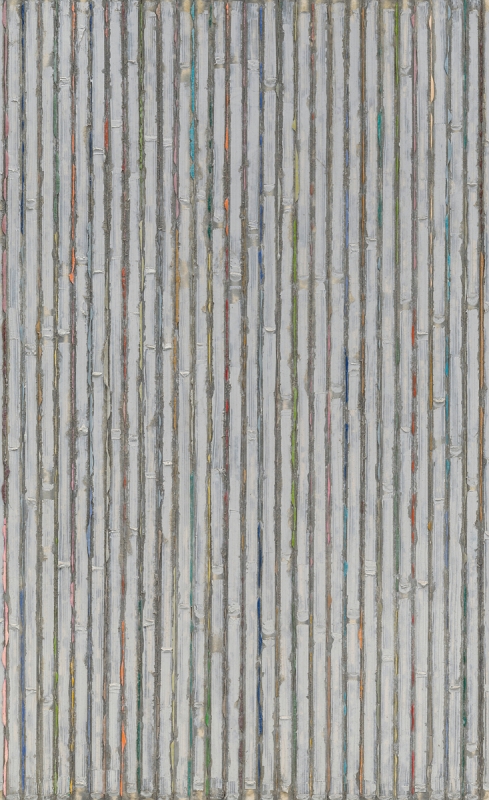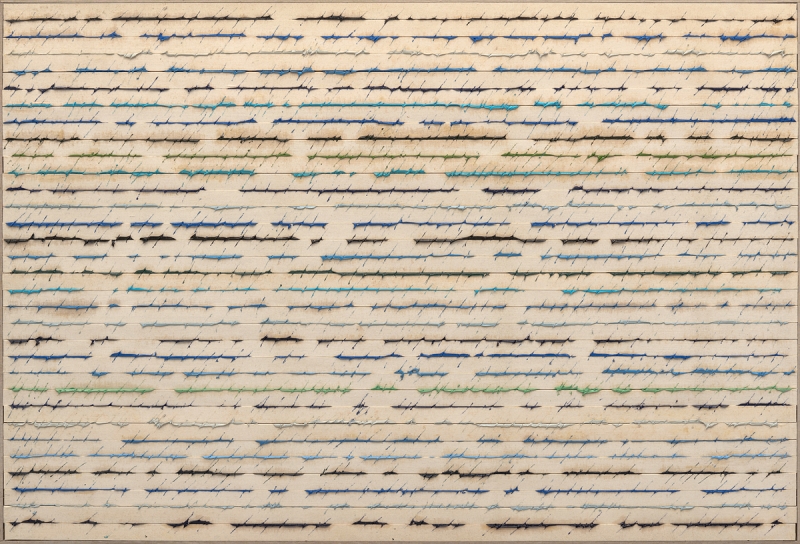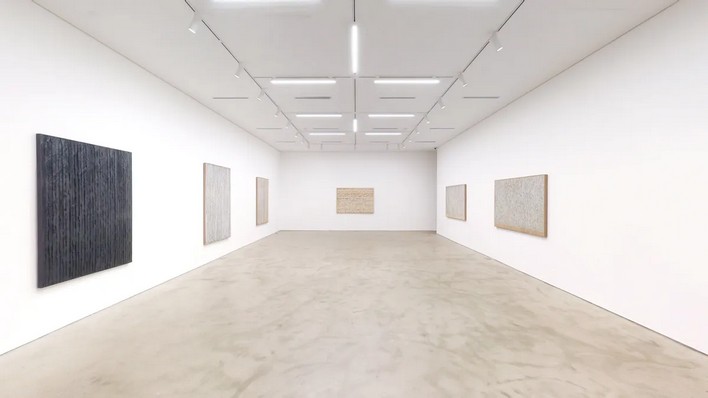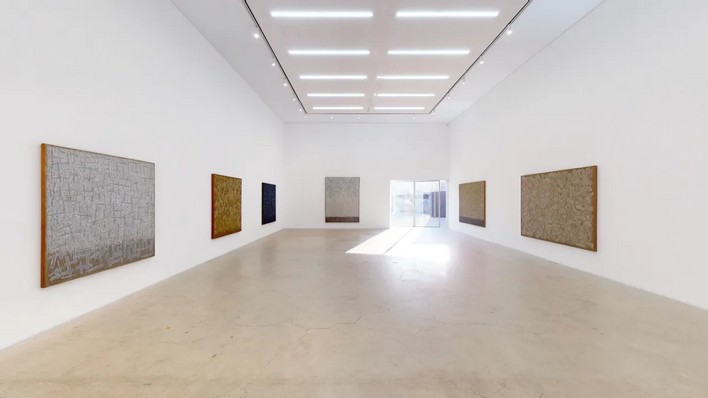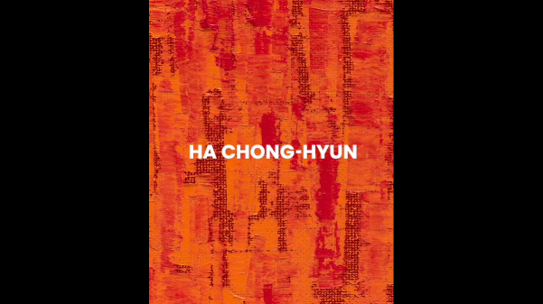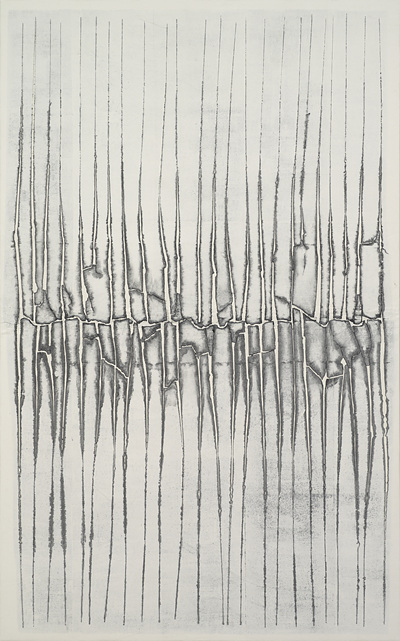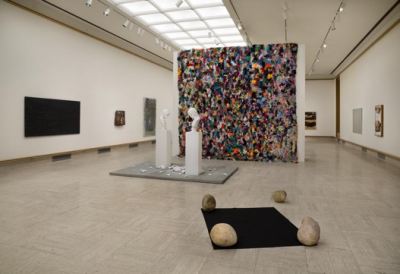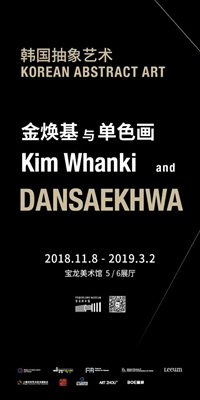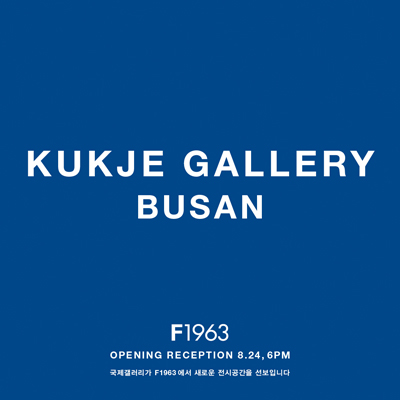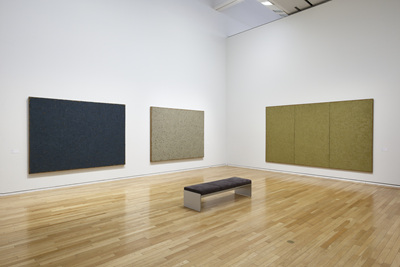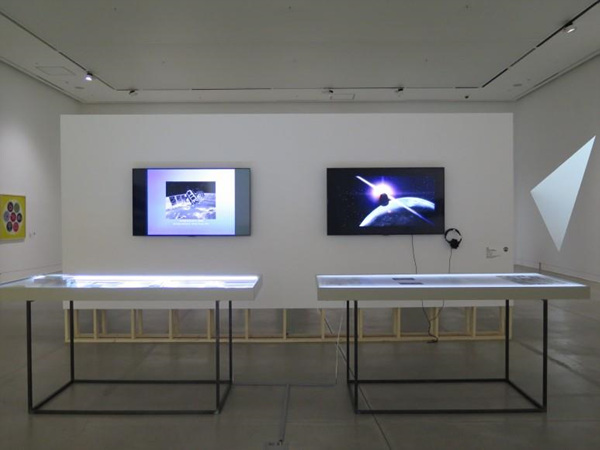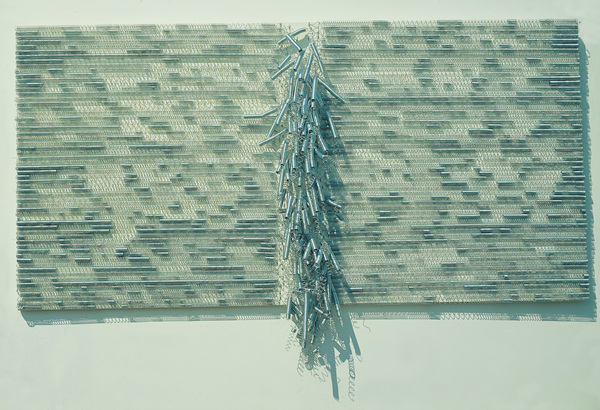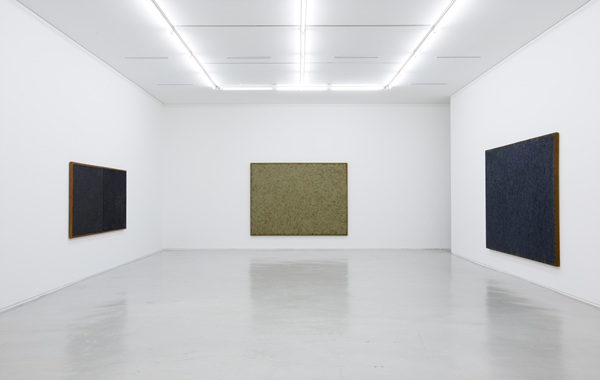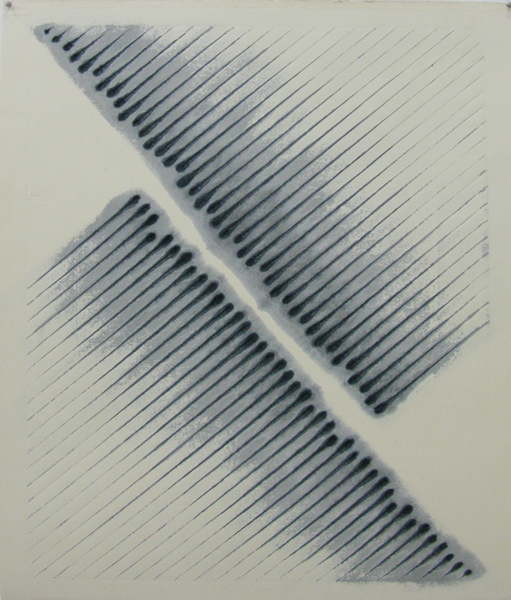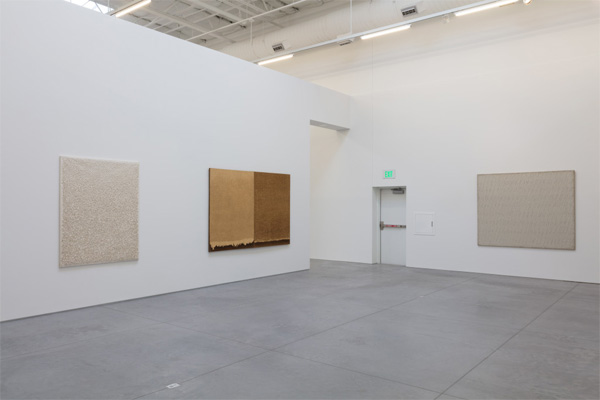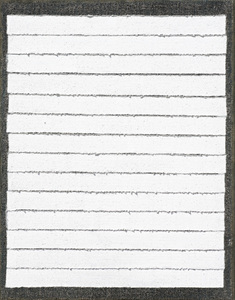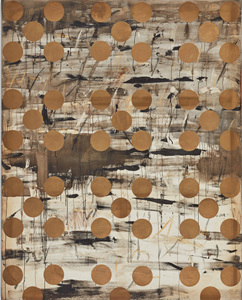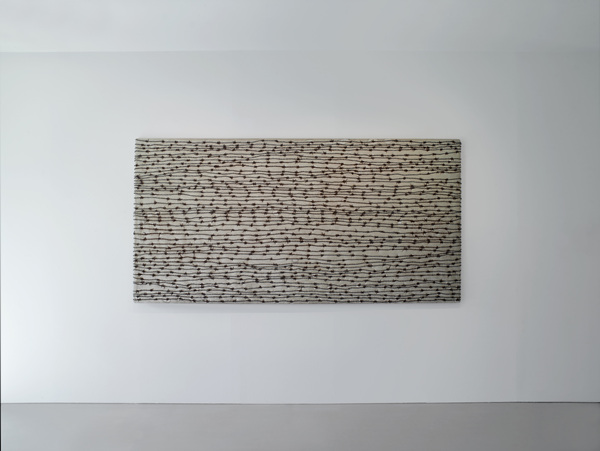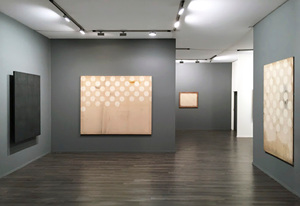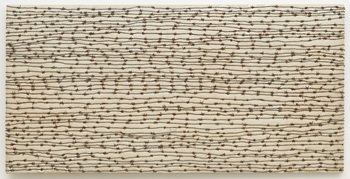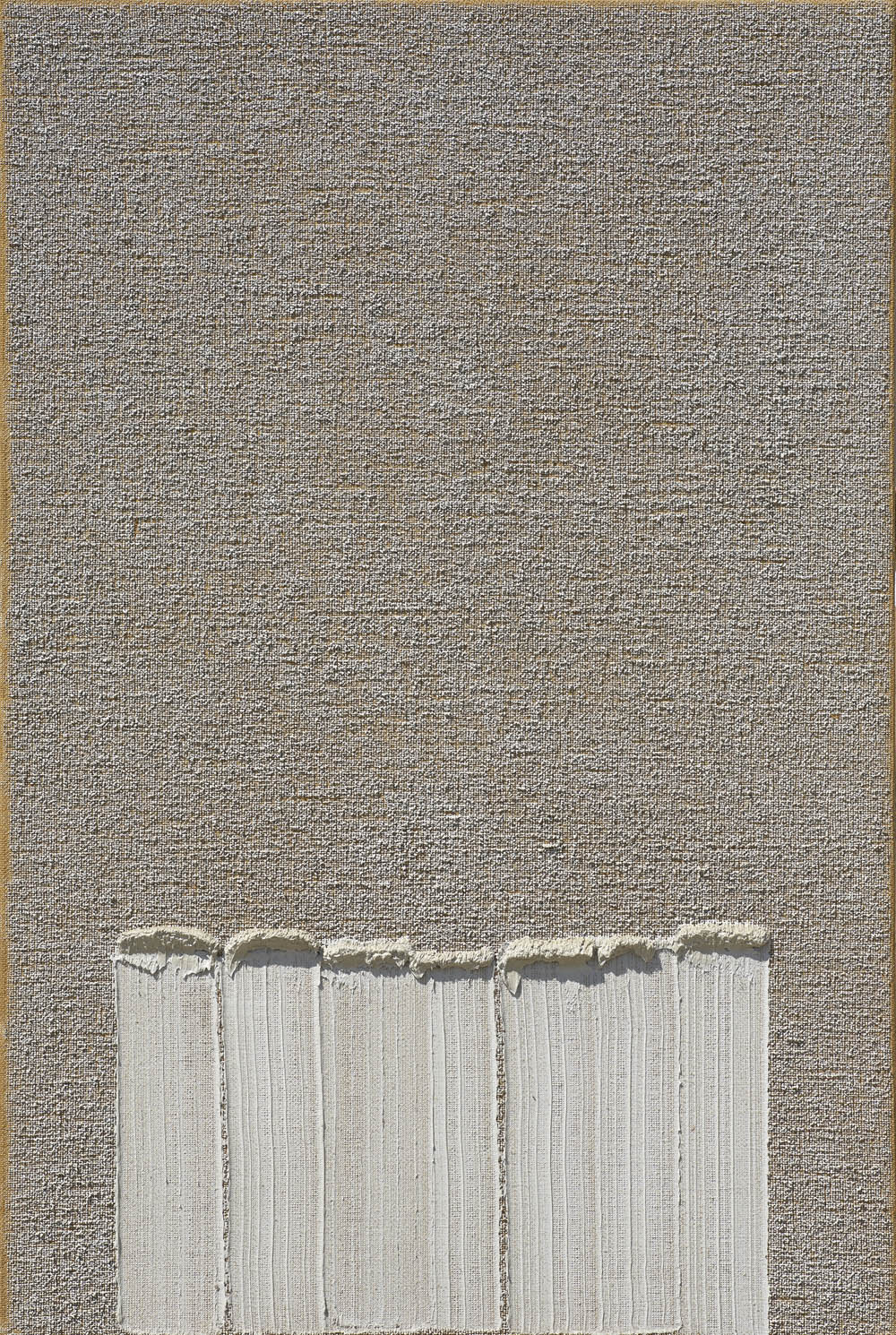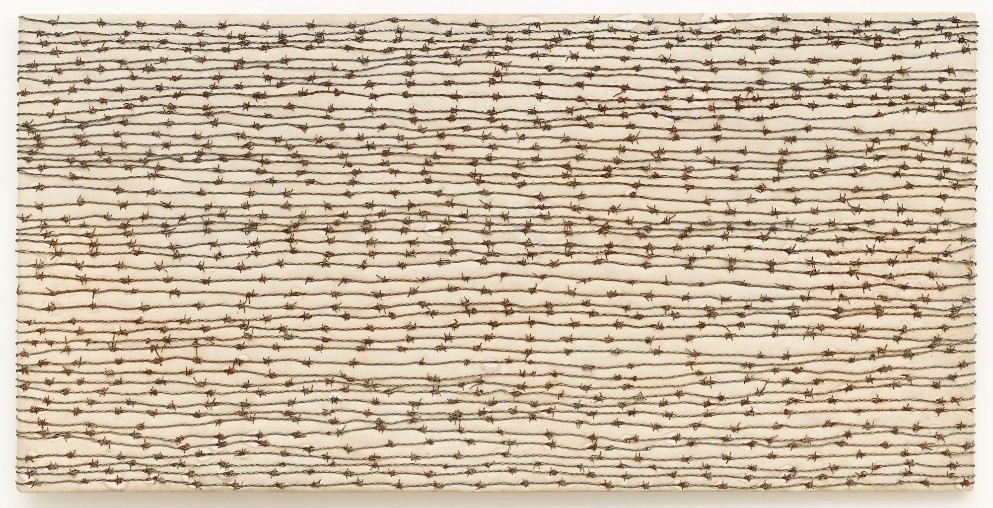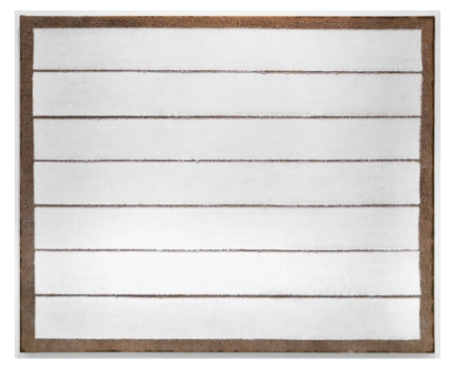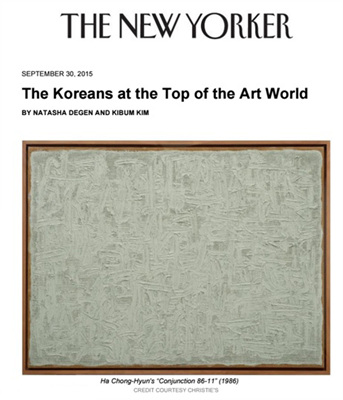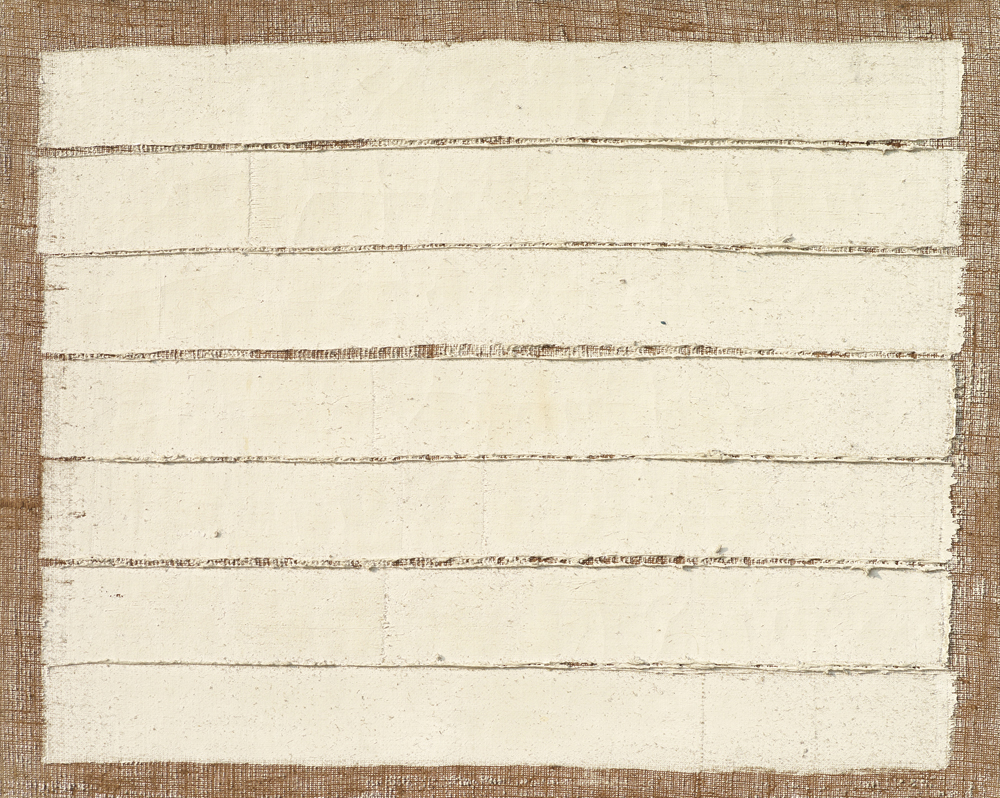 HA CHONG-HYUN | KUKJE GALLERY
HA CHONG-HYUN | KUKJE GALLERY
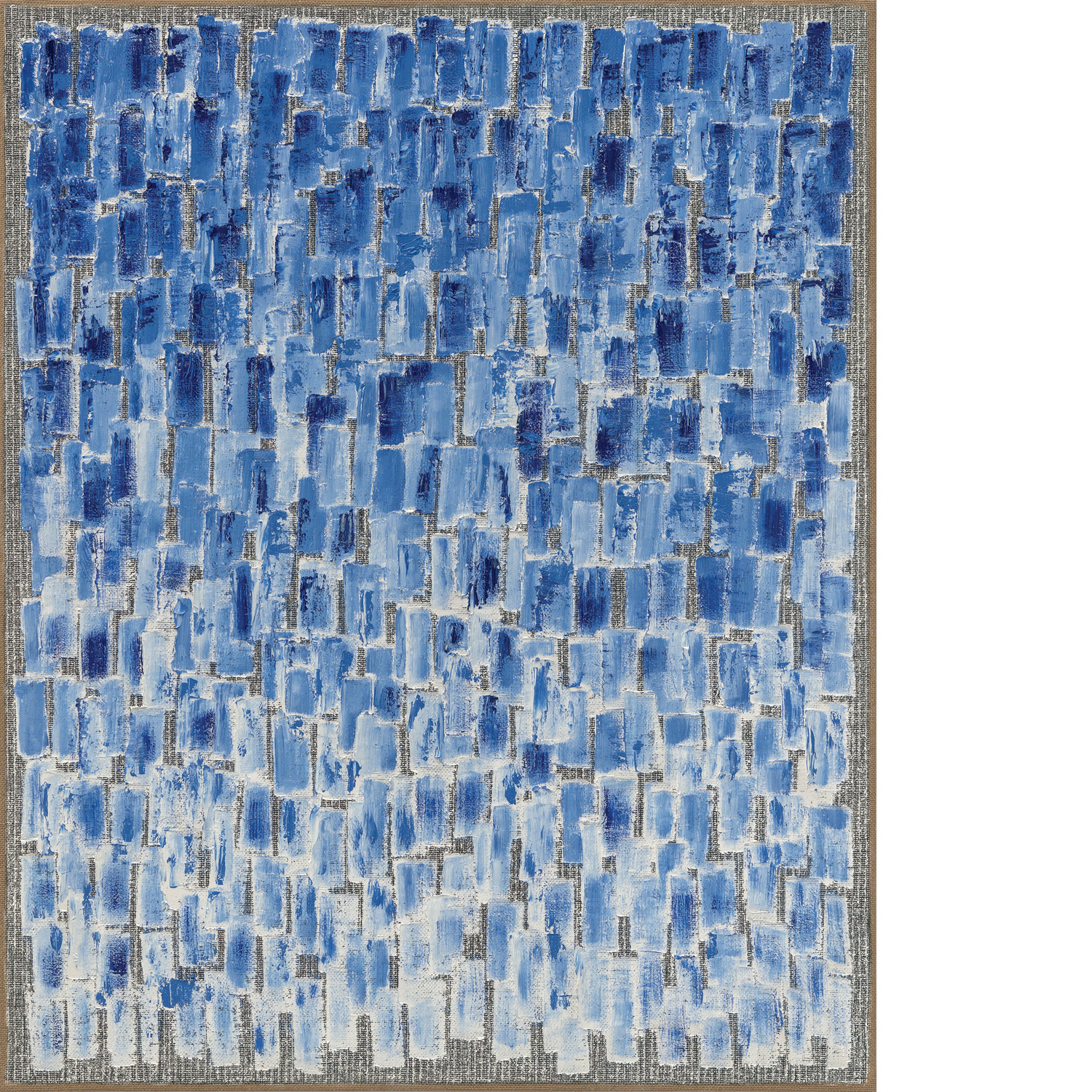
Feb 15, 2022 - Mar 13, 2022
INTRODUCTION
Ha began his Conjunction series in the 1970s, developing it as his signature style over the ensuing decades. The artist cultivated a labor-intensive and innovative technique known as bae-ap-bub, where he pushes oil paint through the coarse weave of the burlap canvas, from the back to the front. While this technique and the unique texture it creates remain evident in the recent multicolored Conjunction series, brushstrokes applied on the back of the canvas and colorful gradations incorporated by the artist reflect a more contemporary palette, as seen in Conjunction 21-38 (2021). The work—which integrates blue and white hues—employs bae-ap-bub with white paint across a surface first treated with black paint, on top of which Ha has drawn vertical lines and manipulated the form and shape of the emergent media. As a final touch, the artist has added blue paint to create a work that deviates from the existing Conjunction pieces. This shift, manifest in the further richness of form and hue, reflects the longstanding relationship between Ha and his use of color. While Ha’s past works were concerned with colors found in Korean traditional roof tiles called giwa, white porcelain, and landscape to honor distinctive forms found throughout the Korean cultural milieu, the recent introduction of bright colors reflects the artist’s efforts to go beyond the parameters of Dansaekhwa, which has been a defining framework for his work during the past decades.
Meanwhile, the Post-Conjunction series includes work that reinterprets and further explores the application of bae-ap-bub, along with Ha's method of composing a unique pictorial plane by manipulating the plasticity of the paint and color in uniform bands. Post-Conjunction works begin with cutting thin wooden sticks in linear form and wrapping each individual pieces of wood with canvas covered in ink or paint. The artist then aligns these sticks on the plane; after one wooden piece is placed within the frame of the canvas, oil paint is applied underneath or on its edges, before placing the next. Ha repeats this process until the paint has pushed through the wood in sufficient volume, to articulate the linear forms of the composition. The artist sometimes scratches the paint left on the surface with a tool in order to amplify the dynamics of the pictorial plane, as can be seen in Post-Conjunction 11-3 (2011), or adds more paint for compositional rhythm, as in Post-Conjunction 10-38 (2010)—such variations in Ha’s working process allow his works to express a wide range of nuances.
While the Conjunction series utilizes burlap as a two-dimensional surface, characterized by an emphasis on the paint’s material properties (especially when applied in thick layers), the Post-Conjunction series can be seen as inventing an entirely new pictorial plane created through the artist's unconventional use of wooden sticks, adding a sculptural quality to Ha’s two-dimensional works. Materials used by the artist immediately after the Korean War, such as USAID burlap sacks, flour, and barbed wire, commented directly on the sociopolitical climate of the times, while those for the Post-Conjunction series are no longer anchored to a specific era, but instead cultivate an expanding spectrum of material exploration and open up a new dialogue between painting and object, broadening the overall definition of Conjunction.
A pioneer of Korean modernism, Ha is an artist whose lifelong work illustrates his commitment to exploring the infinite possibilities and materiality of painting. His practice is defined by this passion for constructing a unique artistic language through two-dimensional works imbued with specific and highly charged material properties and energy. This solo exhibition not only encompasses Ha’s “material exploration” that has defined his career and allowed him to reflect his own life and time, but also provides an opportunity for a new discourse on the Conjunction and Post-Conjunction series, both of which have expanded the definition of painting in seminal ways.
Meanwhile, Ha will hold a major retrospective exhibition in Venice as a Collateral Event of the Biennale Arte 2022 with the support of Kukje Gallery and Fondazione Bevilacqua La Masa from April 21 to August 24, 2022, at the historical Palazzetto Tito. The survey presentation will focus on important chapters of the artist’s ongoing career which spans six decades, introducing his perspectives on the development of Dansaekhwa while discussing its current state and future development.
About the Artist
Born in 1935 in Sancheong, Ha Chong-Hyun graduated from the Department of Painting at Hongik University in 1959, later serving as the Dean of the Fine Arts College at Hongik University (1990-1994) and the Director of the Seoul Museum of Art (2001-2006). Ha has been the focus of major retrospectives at the National Museum of Modern and Contemporary Art, Korea, Gwacheon (2012); Gyeongnam Museum of Art, Changwon (2004); Fondazione Mudima, Milan (2003); and has recently held solo exhibitions across galleries in New York, London, and Paris. Ha has been acknowledged as a founding member of Dansaekhwa, participating in group exhibitions including Korean Abstract Art: Kim Whanki and Dansaekhwa (2018) at the Powerlong Museum in Shanghai; When Process becomes Form: Dansaekhwa and Korean Abstraction (2016) at Villa Empain – Boghossian Foundation, Brussels; Dansaekhwa (2015), an official Collateral Event in the 56th Venice Biennale; and Dansaekhwa: Korean Monochrome Painting (2012) at the National Museum of Modern and Contemporary Art, Seoul. His works are housed in the collections of prominent institutions around the world, including the Centre Pompidou, Paris; OCT Boxes Art Museum, Guangzhou; Museum Voorlinden, Wassenaar; Museum of Modern Art and Solomon R. Guggenheim Museum, New York; Art Institute of Chicago; M+, Hong Kong; Tokyo Metropolitan Art Museum; National Museum of Modern and Contemporary Art, Korea; and Leeum Museum of Art, Seoul.
국제갤러리는 세계적으로 주목받는 단색화의 선구자 하종현의 개인전을 오는 2월 15일부터 3월 13일까지 서울점 전관(K1, K2, K3)에 걸쳐 개최한다. 지난 2015년, 2019년에 이어 국제갤러리에서 열리는 작가의 이번 세 번째 개인전은 그중 가장 큰 규모로, ‘회화란 무엇인가’라는 화두 아래 평생 유화를 다뤄온 하종현의 색채에 대한 지속적인 실험과 물성 탐구의 결과물을 조망하는 자리다. 특히 기존의 ‘접합(Conjunction)’ 연작과 여기서 비롯된 다채색의 ‘접합’, 그리고 최초로 공개하는 신작 ‘이후 접합(Post-Conjunction)’ 연작 등 1990년대부터 현재까지 쉼없이 진화 및 확장되고 있는 하종현의 작업세계를 일괄한다.
1970년대부터 시작된 ‘접합’ 작업은 지난 수십 년 동안 하종현의 대표 연작으로 자리매김했다. 작가는 올이 굵은 마포 뒷면에 두터운 물감을 바르고 천의 앞면으로 물감을 밀어 넣는 배압법(背押法)으로 노동집약적이고 독창적인 기법을 구축했다. ‘접합’의 방식과 형태를 고수하되 색에 대한 동시대적 고민이 반영된 다채색의 ‘접합’ 신작에서는 캔버스 뒷면에서 만들어진 작가의 붓 터치와 함께 흰색이 섞인 색의 그라데이션이 강조된다. 예컨대 청색과 흰색이 어우러진 작품 <Conjunction 21-38>(2021)은 검정 물감으로 표면 밑작업을 한 마포의 뒷면에서 앞면으로 흰색 물감을 밀어 넣고, 줄자를 대어 바탕에 줄을 그은 후, 그 위에 흰색 물감을 칠하고 다시 청색 물감을 얹히는 방식으로 제작된 것이다. 기존 ’접합’ 연작에서 기왓장이나 백자를 연상시키는 한국적인 색상이 주로 사용되었다면, 다채색의 ‘접합’ 신작에서는 일상적인 밝은 색상이 도입되어 보다 현대적으로 다가온다. 작가와 색채 간의 오랜 관계를 반영한 일련의 변화가 화면에서 더욱 풍부하게 변주된 색조와 형태로 나타나는 것이다. 하종현 작가는 다채색을 활용하는 이러한 열린 시도를 통해 오랜 시간 본인의 작업을 정의 내린 단색화라는 틀을 넘어 시대의 흐름을 담아내고자 한다.
한편 ‘이후 접합’ 연작은 기존 ‘접합’ 연작의 주요 방법론이었던 배압법을 응용, 색과 형태뿐만 아니라 회화의 화면을 대하는 태도와 방식 자체를 재해석하고 탐구한 작업이다. ‘이후 접합’은 나무 합판을 일정 크기의 얇은 직선 형태로 자른 후, 그 개별의 나무 조각을 일일이 먹이나 물감을 칠한 캔버스 천으로 감싸는 작업으로 시작된다. 작가는 이 나무 조각들을 화면에 순차적으로 나열하는데, 캔버스 틀에 하나의 나무 조각을 배치하고 바로 아래 혹은 가장자리에 유화 물감을 약간 짠 다음 또 다른 나무 조각을 붙여 놓는 식이다. 이 과정에서 물감이 눌리며 그 흔적이 나란히 배열된 나무 조각 사이로 스며 나오게 된다. 이렇게 전반적인 회화의 화면을 구성한 후, 때에 따라 <Post-Conjunction 11-3>(2011)에서 보이듯 스크래치를 하여 역동적으로 표현하거나 <Post-Conjunction 10-38>(2010)처럼 유화 물감으로 덧칠하여 화면의 리듬감과 율동감을 살리는 등 다채롭게 변주된 작업방식은 각기 다른 형태와 뉘앙스의 작품으로 완성된다.
기존 ‘접합’ 연작이 마대를 평면적으로 사용하고 두터운 물감으로 물성을 살린 작업이라면, ‘이후 접합’ 연작은 나무 조각 자체의 물성으로 새로운 의미의 표면을 형성하는, 즉 평면에 조각적인 요소를 가미하여 입체성을 부여한 작업이다. 한국전쟁 직후 작가가 주로 활용한 재료인 마대 자루, 밀가루, 철조망 등이 시대를 직접적으로 반영했다면, 현재 그가 ‘이후 접합’에서 사용하고 있는 재료는 더 이상 시대에 국한되지 않는다. 오히려 ‘이후 접합’에서 나무 조각의 사용은 물성 탐구의 연장선으로서 회화와 오브제의 ‘접합’을 이루고, 새로운 회화적 평면을 창조하며 ‘접합’의 범주를 확장하는 적극적인 움직임으로 이어진다.
평생 회화의 무한한 가능성에 대한 연구를 놓지 않은 하종현은 물성 실험과 특유의 에너지로 직조된 평면 작업을 통해 자신만의 회화언어를 구축해온, 명실상부 한국적 모더니즘의 개척자다. 그런 면에서 이번 개인전은 서구 미술에 기대지 않은 채 작가 스스로 발견한 재료와 방식의 실험정신은 물론 잠재된 정서를 회화로 소환시키는 집요한 노동으로 본질과의 ‘접합’을 이루고자 한 하종현의 작업정신을 망라한다. 이와 함께 회화의 정의와 개념을 확장해온 기존 ‘접합’ 연작과 한발 진화한 ‘이후 접합’ 연작이 처음으로 같은 자리에서 작가의 역사를 관통하는 상호 간의 담론을 형성할 것으로 기대를 모은다.
한편 하종현은 3년 만에 열리는 베니스 비엔날레 기간인 2022년 4월 21일부터 8월 24일까지, 베니스 팔라제토 티토(Palazzetto Tito)에서 현지 비영리 기관인 폰다치오네 베비라콰 라 마사(Fondazione Bevilacqua La Masa)의 주최 하에 회고전을 개최한다. 이번 전시는 여전히 진행 중인 그의 60년 화업 중에서도 가장 결정적인 시기 및 지점에 특히 집중한다. 하종현이라는 작가를 역사적으로 재조명할 뿐 아니라 단색화에 대한 작가의 오랜 고찰을 통해 단색화의 현주소를 논할 수 있는 유의미한 자리가 될 것이다.
작가 소개
1935년 경남 산청에서 출생한 하종현은 1959년 홍익대학교 회화과 졸업 후 홍익대학교 미술대학 학장(1990-1994)과 서울시립미술관 관장(2001-2006)을 역임했다. 밀라노 무디마 현대미술재단(2003), 경남도립미술관(2004), 국립현대미술관 과천관(2012)에서 대규모 회고전을 개최했으며, 뉴욕, 런던, 파리 등 전세계 갤러리에서 다수의 개인전을 선보였다. 단색화를 대표하는 작가로서, 국립현대미술관 《한국의 단색화》(2012), 제56회 베니스 비엔날레 병행전시 《단색화》(2015), 벨기에 보고시안 재단 《과정이 형태가 될 때: 단색화와 한국 추상미술》(2016), 상하이 파워롱미술관 《한국의 추상미술: 김환기와 단색화》(2018) 등 주요 단색화 그룹전에도 참여했다. 하종현의 작품은 최근 소장된 파리 퐁피두 센터를 비롯해 중국 박시즈 미술관, 네덜란드 보르린던 현대미술관, 뉴욕 현대미술관(MoMA), 구겐하임 미술관, 시카고 미술관, 홍콩 M+, 도쿄도 현대미술관, 국립현대미술관, 리움미술관 등 주요 미술기관에 소장되어 있다.
WORKS
|
Conjunction 21-38 |
Conjunction 21-82 |
|
|
Conjunction 20-99 |
Conjunction 21-51 |
|
|
Conjunction 99-03 |
Post-Conjunction 21-201 |
|
|
Post-Conjunction 09-02 (A) |
Post-Conjunction 11-3 |
|
INSTALLATIONS
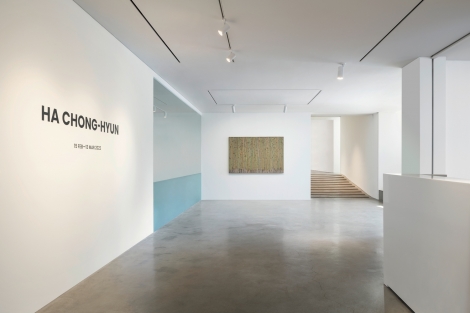
|
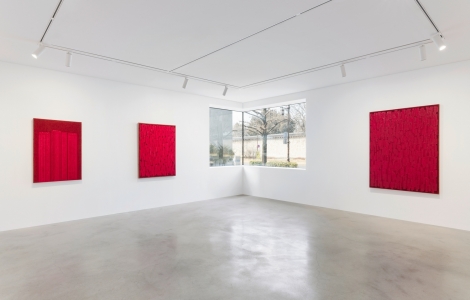
|
|
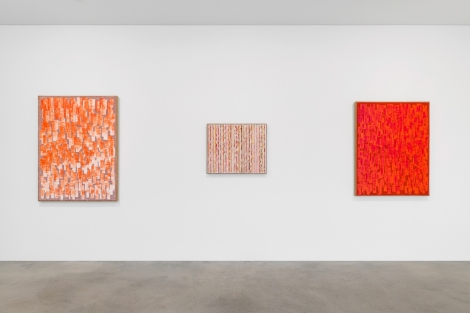
|
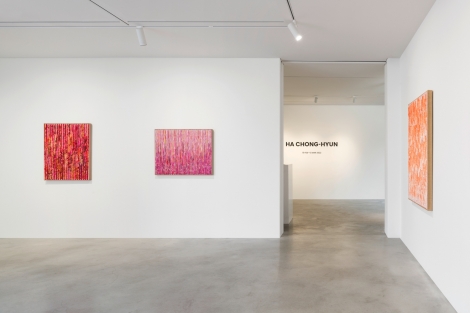
|
|
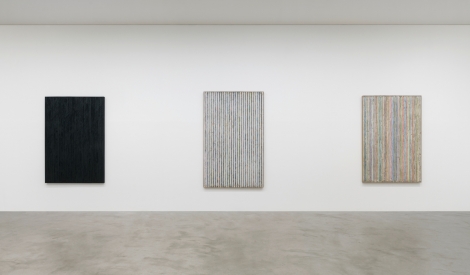
|
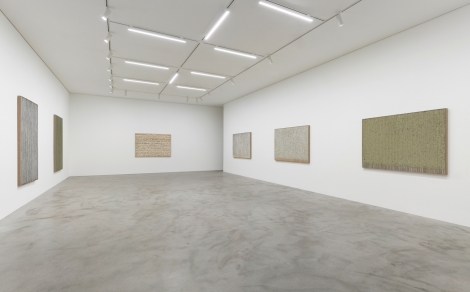
|
|
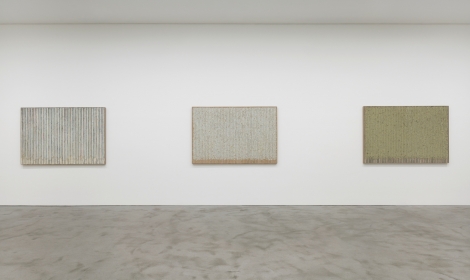
|
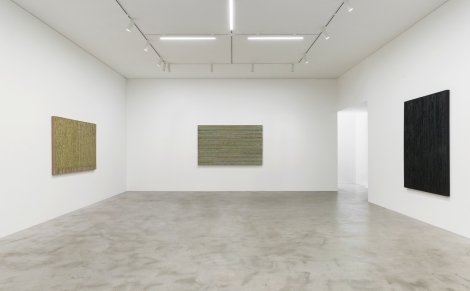
|
|
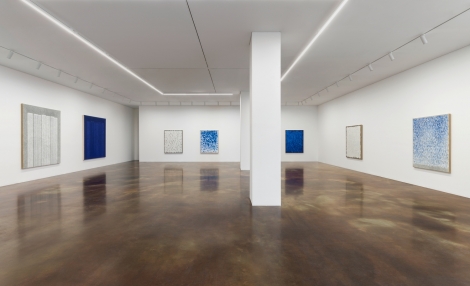
|
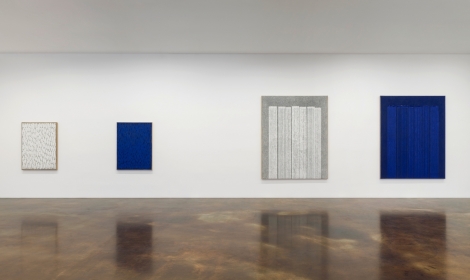
|
|

|
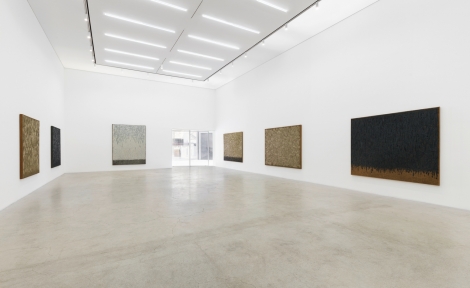
|
|
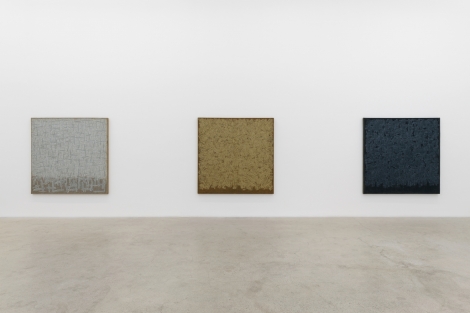
|
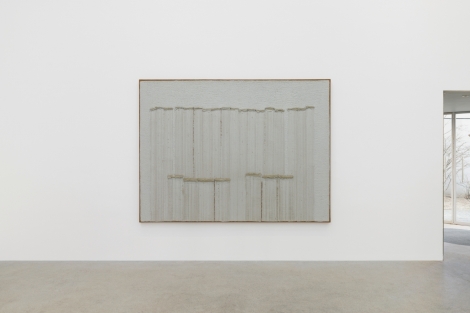
|
|
VIDEOS
|
Installation Video |
Virtual Exhibition |
|
|
Virtual Exhibition |
Virtual Exhibition |
|
|
Teaser Trailer |
MEDIA COVERAGE
일간지
월간지
주간지/웹
